Dissertation brain is a nasty thing. It’s like culture goggles, or other loss of vision, but you also forget to do all the things that you like. While I still have dissertation brain, and will likely have it for another year (plus or minus 6 months), I was happen when something translation related popped up in my life and I was aware enough to think it cool, worthy of note, and not something that i needed to somehow put into the dissertation. Merry days!
I went to a wedding today. A wedding of an old friend and his (now) wife. He is American (Hawaii/California/Oregon); she is Japanese (Osaka). He speaks English and Japanese; she speaks Japanese, and the smidgen of English glommed through Middle/High School education, but repeatedly denied in practice. Certainly the combination is hardly unusual given the second half of the 20th century and Western colonial practices. Their daily language mediation (speaking in Japanese) is not what interested me. Rather, what interested me was the 3-way that occurred during the wedding ceremony.
Picture, if you will, a bride on one side, a groom on the other, and a pastor in the middle (I’m not sure what denomination, but the other half of his work is as a surf instructor, if that helps). It’s not an unusual picture: it’s the heteronormative one, in fact. However, what is interesting is that I have become used to thinking about that positioning and relationship in a slightly different manner.
In the course of the past weddings I’ve attended (particularly of same-sex couples), the relationship is of a triangle with the (possibly) the officiator in a position of power, but the couple in a position of equality. Each side goes into the ceremony (and marriage) with equal power. Of course, such is not necessarily true, nor has it tended to be true historically. That said, the typical marriage oaths that Hollywood has spread include ideals of equality: each side says the same thing, each side talks about loving and cherishing, sickness and health, good times and bad, etc. Each side is an equal partner.
Unsurprisingly, this wasn’t always the case (surprise surprise). For example, the 1549 Church of England’s Booke of Common Prayer ceremony required the bride to say “to love, cherish, and to obey” to the groom. And of course, when it’s simply a matter of trading horses for women equality goes right out the window. However, that’s not my point here. Rather…
What interested me about the wedding ceremony today is that, due to the bride’s (and her family’s) inability to speak English fluently, the groom translated. Yes, there were other people who spoke Japanese at the ceremony, quite a few, in fact, but not the pastor, and anybody else speaking in that position would have broken the important triangular relationship. So, re-picture, if you will, the bride on one side, the groom on the other, and the pastor in the middle, but now, every time the pastor speaks an utterance, he must stop and the groom must translate.
It’s a part of their daily life, yes, however, given the marriage ceremony it does other, interesting things. The constant effort of the groom to properly translate, even when struck with more difficult phrasing and terminology, is admirable. This is particularly true given that he is an English teacher, not a Japanese-English translator, let alone an English-Japanese translator. Thus, there are two interesting points that I wish to describe and then show why I find them interesting.
First/Second/Third Person
The groom first had trouble when the pastor stated, “I’m honored that you chose me to be your pastor.” It’s not a difficult phrase, and the groom had already translated both honored and pastor, the only real vocabulary of the phrase. And yet, the groom stuttered over the phrase because of a difficulty in roles and position.
At that point the groom was unable to be ‘himself,’ the groom that was translating the pastor for his bride-to-be. Instead, he was suddenly the translator mediating the pastor. And as a tangled subject, he had difficulty with his phrasing. Was he to say “the pastor says, ‘I’m honored that you chose me to be your pastor'”, or was he to say “I’m honored that you chose me to be your pastor.” The groom ended with “ã¨è¨€ã†” but did not start with “牧師,” a cop-out of sorts. So, he says the “said”, but not who said it.
The first issue was interesting as shows the troubles of mediation when you are within the situation yourself. Essentially, that there was a double mediation.
Repeating Vows
The second problem moment came during the home stretch, when the pastor went into the marriage vow section. What is the groom to do when told to “repeat after me. I, Bryan…”? Obviously, to repeat the sentences that begin with I and include the various honoring, cherishing and loving. To repeat word-for-word the ‘legally’ binding phrasing. But what is the translator to do when told to “repeat after me”? Obviously, to translate the phrase ‘repeat after me’ and anything that comes after it.
At this point, the groom did not “repeat” the binding vows, but translated them (with some trouble, I might add). Interestingly, he was at this point not only translating, but talking to his bride who does not speak English enough to understand the vow in English. As such, the vow was less about the legally/religiously binding phrasing than it was telling the bride how he (as the groom) would treat her, honor her, etc, etc.
Next came the bride’s turn, When told to “repeat after me: I, Yuri…” she did not mimic the groom and translate the phrases into her native Japanese as she did not understand them enough to do so, nor was her memory of the groom’s translation sound enough to reproduce the same phrases (mistakes and all). Instead, she repeated the pastor as best she could: Ai, Yuri, teeku Buraian, tsu bii mai…” Unlike the groom, she did what she was supposed to do and uttered the legally/religiously binding words, but she did so without a full understanding of just what she was saying.
So, in the end you have two people who have given different vows, each mediated in a different way through language, ceremony, bureaucracy, pomp and circumstance. Does this change their marriage in any way? Of course not. That ceremony had nothing to do with the legal binds of marriage that they went through in Osaka, and it likely has nothing to do with the papers they may or may not submit to California. While their differences might not be important to the marriage, they are interesting to the situation. While the pastor is the official mediator in his (in this case it was a he) role as interface between couple and higher powers (church/state), it was the groom that acted as mediator here, and in so doing marked out very interesting power relationships. The mediator/translator is, as I firmly believe, an interface. However, interfaces are not invisible, or just about the user, despite what Norman and others say. In the case of the wedding, who is the ‘user’? Is it the groom? The bride? The pastor? The audience? A user necessitates a particularly stable role that does not exist with translation as interface. As such, both translation and interface must be reinterpreted as unstable qualities and positions.
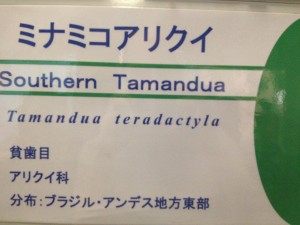 This is everywhere. I just came from the Ueno Zoo, and all standardized signs were written with katakana (despite the animal’s nativity) with English underneath, then the Latin name, and finally in the standard usage with both kanji and hiragana to describe the animal’s eating habits and place of origin. And any argument that katakana might be easier to read for children does not hold, as the nearby signs saying not to feed the animals (arguably what children must read and understand) is written in hiragana, not katakana.
This is everywhere. I just came from the Ueno Zoo, and all standardized signs were written with katakana (despite the animal’s nativity) with English underneath, then the Latin name, and finally in the standard usage with both kanji and hiragana to describe the animal’s eating habits and place of origin. And any argument that katakana might be easier to read for children does not hold, as the nearby signs saying not to feed the animals (arguably what children must read and understand) is written in hiragana, not katakana. 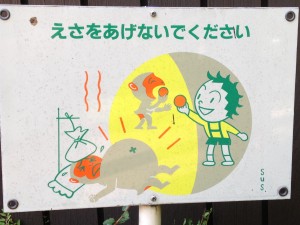 The animal, as an essentially alterier creature, is unknowable/not human, and it is marked as such through katakana. Just like you can never get in the cages, the animals can only be known from afar. Similarly, foreignness is held at bay linguistically through a simultaneous embrace and rejection through the constant utilization, but never full incorporation. Such mixture is a major part of Japan. Not the the most important part, but definitely an important element. So, why then if translation is supposed to bring understanding, does translation never deal with this? And, no, I’m not arguing that Japan is loveydovey, and translations must represent this. Rather, I’m arguing that it is the ethical responsibility of translations not simply to be enjoyable, but to bring understanding of what it is like to consume that text in its place of origin. A text does not travel as some unmarked pleasure, ready for easy consumption, but loaded down with context, necessarily.
The animal, as an essentially alterier creature, is unknowable/not human, and it is marked as such through katakana. Just like you can never get in the cages, the animals can only be known from afar. Similarly, foreignness is held at bay linguistically through a simultaneous embrace and rejection through the constant utilization, but never full incorporation. Such mixture is a major part of Japan. Not the the most important part, but definitely an important element. So, why then if translation is supposed to bring understanding, does translation never deal with this? And, no, I’m not arguing that Japan is loveydovey, and translations must represent this. Rather, I’m arguing that it is the ethical responsibility of translations not simply to be enjoyable, but to bring understanding of what it is like to consume that text in its place of origin. A text does not travel as some unmarked pleasure, ready for easy consumption, but loaded down with context, necessarily.


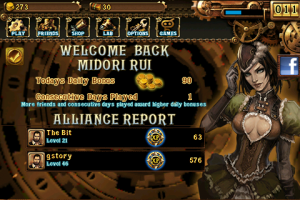




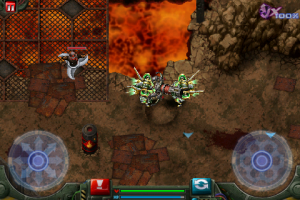
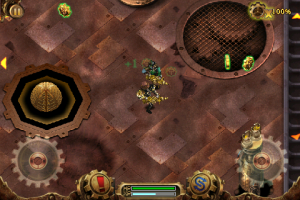

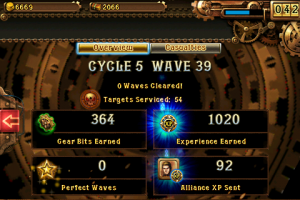

 This book alone would make translation an interesting task as it would be translation, not localization. But the particular use of language within the game makes it even more complicated. The in-game alphabet is based off of the Japanese 46 character syllabary with corresponding characters including “, ° and ã£. Such a one to one choice is far from unknown: FFX had a similar trick with the
This book alone would make translation an interesting task as it would be translation, not localization. But the particular use of language within the game makes it even more complicated. The in-game alphabet is based off of the Japanese 46 character syllabary with corresponding characters including “, ° and ã£. Such a one to one choice is far from unknown: FFX had a similar trick with the  , which transliterates to ã¾ã˜ã£ãã¾ã™ãŸãƒ¼, which transliterates to English as majikku masutaa, or Magic Master. This is on the cover of the book and there are paragraphs of the game language throughout the book at various points. One expects it is in the game world as well. To localize the game the ties between the in world language and the player’s language must be untied and then retied. To do that for English the 46 characters must be weeded down to 26, which is easy enough on a surface level, but more difficult if anything in the game uses some of the 20 deleted characters in an interactive way.
, which transliterates to ã¾ã˜ã£ãã¾ã™ãŸãƒ¼, which transliterates to English as majikku masutaa, or Magic Master. This is on the cover of the book and there are paragraphs of the game language throughout the book at various points. One expects it is in the game world as well. To localize the game the ties between the in world language and the player’s language must be untied and then retied. To do that for English the 46 characters must be weeded down to 26, which is easy enough on a surface level, but more difficult if anything in the game uses some of the 20 deleted characters in an interactive way.